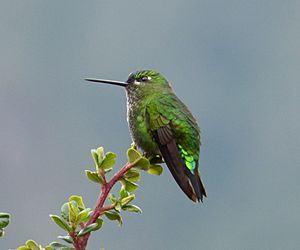Black-thighed puffleg facts for kids
Quick facts for kids Black-thighed puffleg |
|
|---|---|
 |
|
| Conservation status | |
| Scientific classification | |
 |
|
| Synonyms | |
|
Eriocnemis derbianus |
The black-thighed puffleg (Eriocnemis derbyi) is a super cool type of hummingbird. It's part of a group called "brilliants." You can find this amazing bird living in the mountains of Colombia and Ecuador.
Contents
Meet the Black-thighed Puffleg
This special hummingbird is about 10 centimeters (4 inches) long. It has a straight, dark bill.
What Does it Look Like?
Male black-thighed pufflegs are mostly shiny golden-green. They sometimes have black highlights. Their upper and lower tail feathers are a sparkling malachite green. The most unique part? They have fluffy black feathers on their legs, which look like little leg warmers! Their tail is black and shaped like a fork.
Female pufflegs are a bit different. They have white undersides with green spots. Their leg puffs are a mix of black and grayish-white. Females also have a hint of blue on their forehead. Young pufflegs look a lot like the females.
Where Do They Live?
The black-thighed puffleg lives in the Central Andes mountains. You can find them from the Tolima area in Colombia all the way south to the Imbabura area in northwestern Ecuador.
Their Home Environment
These birds like bushy fields and the edges of wet forests. In Colombia, they've also been seen in shrubby ravines. They prefer places that are a bit open, not super dense forests. They live at high altitudes, from about 2,500 to 3,600 meters (8,200 to 11,800 feet) above sea level. They are most common above 2,900 meters (9,500 feet).
How They Live Their Lives
Seasonal Travel
Black-thighed pufflegs move to different elevations depending on the season. This means they travel up and down the mountains throughout the year.
What Do They Eat?
These hummingbirds love to drink nectar from flowers. They usually feed on low-growing plants like Fuchsia and certain palm trees. They also eat insects! They catch insects by "hawking," which means they fly out from a perch to snatch insects in mid-air.
Building a Family
We don't know much about how black-thighed pufflegs raise their young. Their nesting season seems to include February. The female bird sits on two white eggs to keep them warm. We don't know how long it takes for the eggs to hatch or for the chicks to be ready to fly.
Their Special Song
The black-thighed puffleg has a unique call. It's a short, buzzing sound like "tzzrr." They repeat this sound every now and then. They make this sound both when they are sitting on a branch and when they are hovering in the air. This sound is quite different from other puffleg hummingbirds!
Their Conservation Status
The IUCN (International Union for Conservation of Nature) says the black-thighed puffleg is "Near Threatened." This means they could become endangered if we don't protect them.
Why Are They Threatened?
Their home range is not very large. We don't know exactly how many of these birds there are, but their numbers are likely going down. This is mainly because their habitat (the places where they live) is being lost. Even though they are considered uncommon, they can sometimes be found in places changed by humans, like pastures and gardens.
See also
 In Spanish: Zamarrito Muslinegro para niños
In Spanish: Zamarrito Muslinegro para niños


